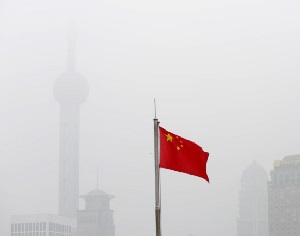Image: Chinese flag is seen in front of the financial district of Pudong amid heavy smog in Shanghai, China, December 23, 2015. REUTERS/Aly Song
![]()
By David Stanway
BEIJING (Reuters) – China’s carbon emissions, by far the world’s highest, may have peaked in 2014, according to a study published on Monday, potentially putting Beijing under pressure to toughen its climate pledges.
China has promised to bring greenhouse gas emissions to a peak by “around 2030” as part of its commitments to a global pact to combat global warming, signed in Paris last year. Evidence that the country has peaked much earlier could lead to concerns that its existing targets are too easy.
The study, by the Grantham Research Institute on Climate Change and the Environment and the ESRC Centre for Climate Change Economics and Policy at the London School of Economics, said that the 2030 peak was a very conservative estimate.
“It is quite possible that emissions will fall modestly from now on, implying that 2014 was the peak,” said the report, noting that recent data already showed that China’s emissions fell in 2015.
“If emissions do grow above 2014 levels … that growth trajectory is likely to be relatively flat, and a peak would still be highly likely by 2025,” the authors said.
While total energy consumption rose 0.9 percent to 4.3 billion tonnes of standard coal in 2015, coal consumption fell 2.2 percent year on a year earlier, according to Reuters calculations based on official data.
Chinese carbon experts said any fall in emissions in 2015 would be mainly due to a slowdown in China’s economy, and it was unlikely that emissions had peaked so early.
“I would like to believe that the peak will be around 2030, and if stricter policies for carbon reduction and some reforms in the way local leaders are evaluated on GDP growth, the peak will come in 2025,” said Xi Fengming, a carbon researcher with the China Academy of Sciences.
“But I do not think China has reached peak emissions in 2014,” he said.
The government said on Saturday that it would cap total energy consumption at 5 billion tonnes of standard coal by 2020, amounting to an increase of 16.3 percent from 2015.
It also said that it would cut carbon intensity – or the amount of CO2 emissions per unit of economic growth – by 18 percent over the 2016-2020 period.
The 2030 peak pledge was made in a joint declaration with the United States in late 2014. China also agreed it would make its best efforts to peak earlier.
One of the main bones of contention during the Paris climate talks was a regular five-year “stocktaking” process that would compel countries to adjust their targets in light of new economic or technological circumstances, with China arguing that any such adjustments must be voluntary.
U.S. climate change envoy, Todd Stern, said in Beijing last week that China could come under pressure to draw up tougher targets if it became clear that the existing goals were too easy.
“It will be up to the Chinese government whether they increase their target but there will obviously be a lot of international opinion looking forward to additional measures – whether it is China or anyone else,” he told reporters.
(Reporting by David Stanway; Editing by Richard Pullin)
Copyright 2015 Thomson Reuters. Click for Restrictions.
China-s-CO2-emissions-may-have-peaked-in-2014-study-media.jpg


